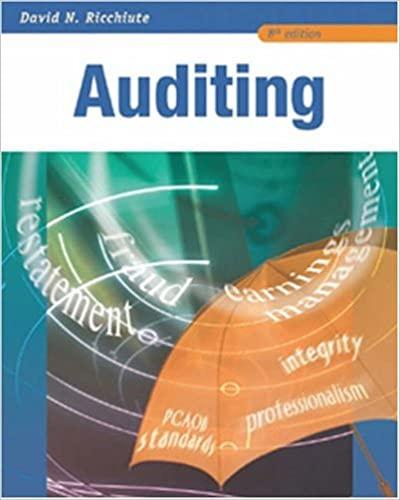Question
1. A. Listed below are 12 accounting liabilities. 1. Rental fees received in advance 2. Interest Payable 3. Unsettled lawsuits where no estimate of loss
1. A. Listed below are 12 accounting liabilities.
| 1. | Rental fees received in advance |
| 2. | Interest Payable |
| 3. | Unsettled lawsuits where no estimate of loss can be made |
| 4. | Accounts payable |
| 5. | Warranties payable |
| 6. | Bonds payable |
| 7. | Subscription fees received in advance |
| 8. | Taxes payable |
| 9. | Employment commitments |
| 10. | Notes payable |
| 11. | Purchase commitments |
| 12. | Salaries payable |
Place the accounting liabilities in one of the following six categories:
| a. | Obligations with fixed payment dates and amounts |
| b. | Obligations with fixed payment amounts but estimated payment dates |
| c. | Obligations for which the firm must estimate both timing and amount of payment |
| d. | Obligations arising from advances from customers on unexecuted contracts and agreements |
| e. | Obligations under mutually executed contracts |
| f. | Contingent obligations |
B. In addition, determine which of the liabilities would be recognized on the balance sheet as liabilities and which would not be recognized.
Suggestion: format your answer as follows (this is not a correct sample answer):
a. Obligations with fixed payment dates and amounts (not generally recognized):
1. Rental fees received in advance
2. In the chart below, assign the directional effect (I = increase, D = decrease, or NE = no effect) of each of the following six transactions on the components of the book value of common shareholders equity.
a. Issuance of $1 par value common stock at an amount greater than par value.
b. Donation by a governmental unit to a corporation.
c. Cash dividend declared.
d. Previously declared cash dividend paid.
e. Property dividend declared and paid.
f. Large stock dividend declared and issued.
| Item | Common Stock | Additional Paid-In Capital | Deferred Compensation | Retained Earnings | Treasury Stock at Cost | Total Common Shareholders Equity |
| a. |
|
|
|
|
|
|
| b. |
|
|
|
|
|
|
| c. |
|
|
|
|
|
|
| d. |
|
|
|
|
|
|
| e. |
|
|
|
|
|
|
| f. |
|
|
|
|
|
|
3. Assume that a start-up manufacturing company raises capital through a series of equity issues.
Required:
a. Using the financial statement template below, summarize the financial statement effects of the following transactions.
(1) Issues 80,000 shares of $1 par value common stock for $10 per share.
(2) Receives land in exchange for 8,000 shares of $1 par common stock when the common stock is trading in the market at $20 per share. The land has no readily determinable market value.
(3) (a) Receives subscriptions for the issue of 30,000 shares of $1 par value common. The share issue price is $20, of which 30 percent is received as a down payment.
(3) (b) Subsequently, the remaining 70 percent is received from the transaction in 3(a).
|
|
|
|
|
| Shareholders Equity | ||||
|
Entry |
Assets |
= |
Liabilities |
+ |
CC |
+ |
AOCI |
+ |
RE |
| 1 |
|
|
|
|
|
|
|
|
|
| 2 |
|
|
|
|
|
|
|
|
|
| 3(a) |
|
|
|
|
|
|
|
|
|
| 3(b) |
|
|
|
|
|
|
|
|
|
Journal entry (optional):
b. In each case, how does the company measure the transaction? What measurement
attribute is used?
Step by Step Solution
There are 3 Steps involved in it
Step: 1

Get Instant Access to Expert-Tailored Solutions
See step-by-step solutions with expert insights and AI powered tools for academic success
Step: 2

Step: 3

Ace Your Homework with AI
Get the answers you need in no time with our AI-driven, step-by-step assistance
Get Started


